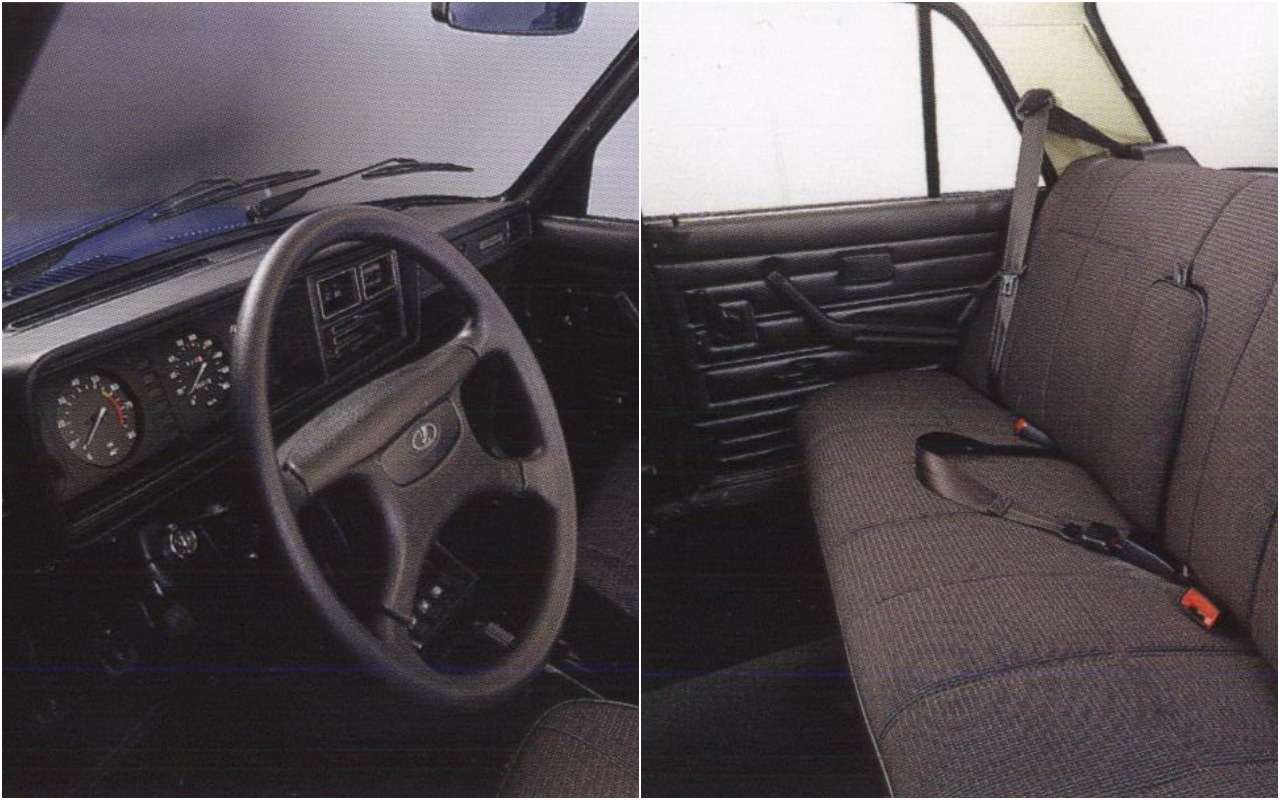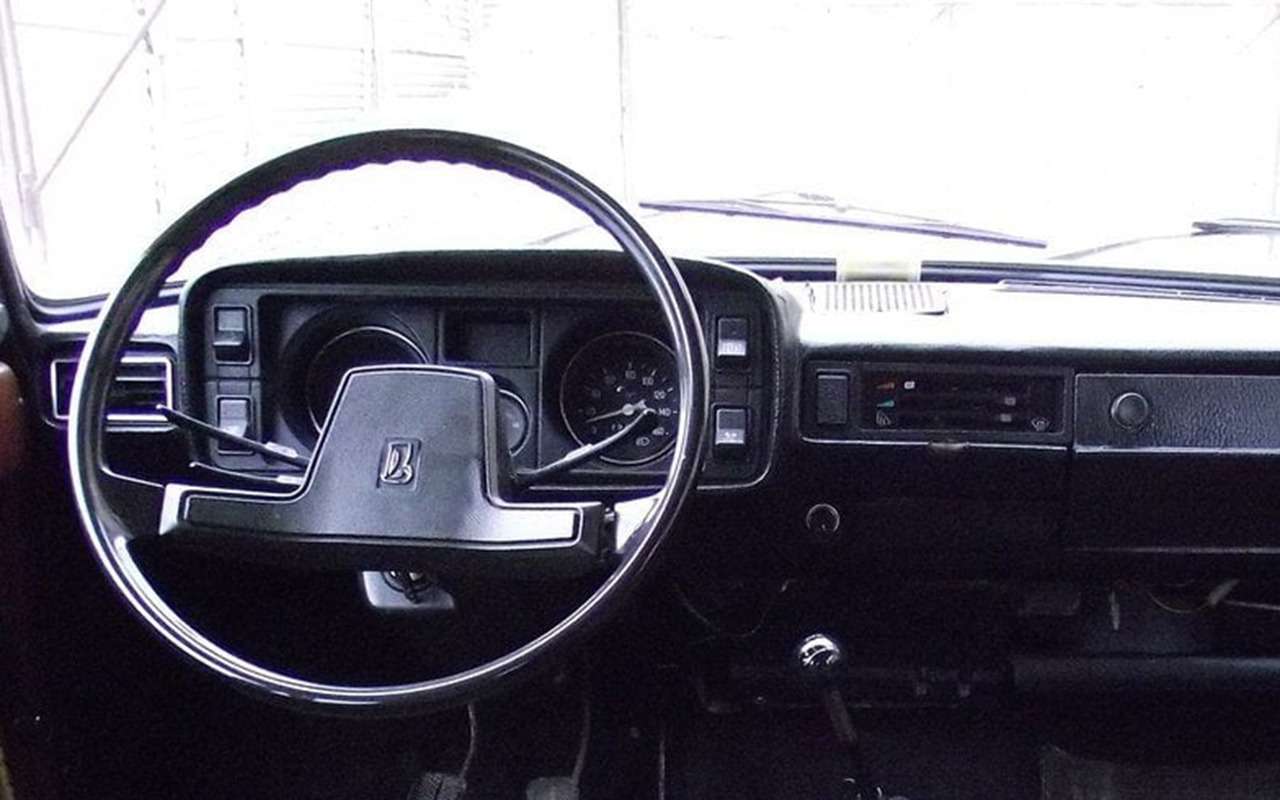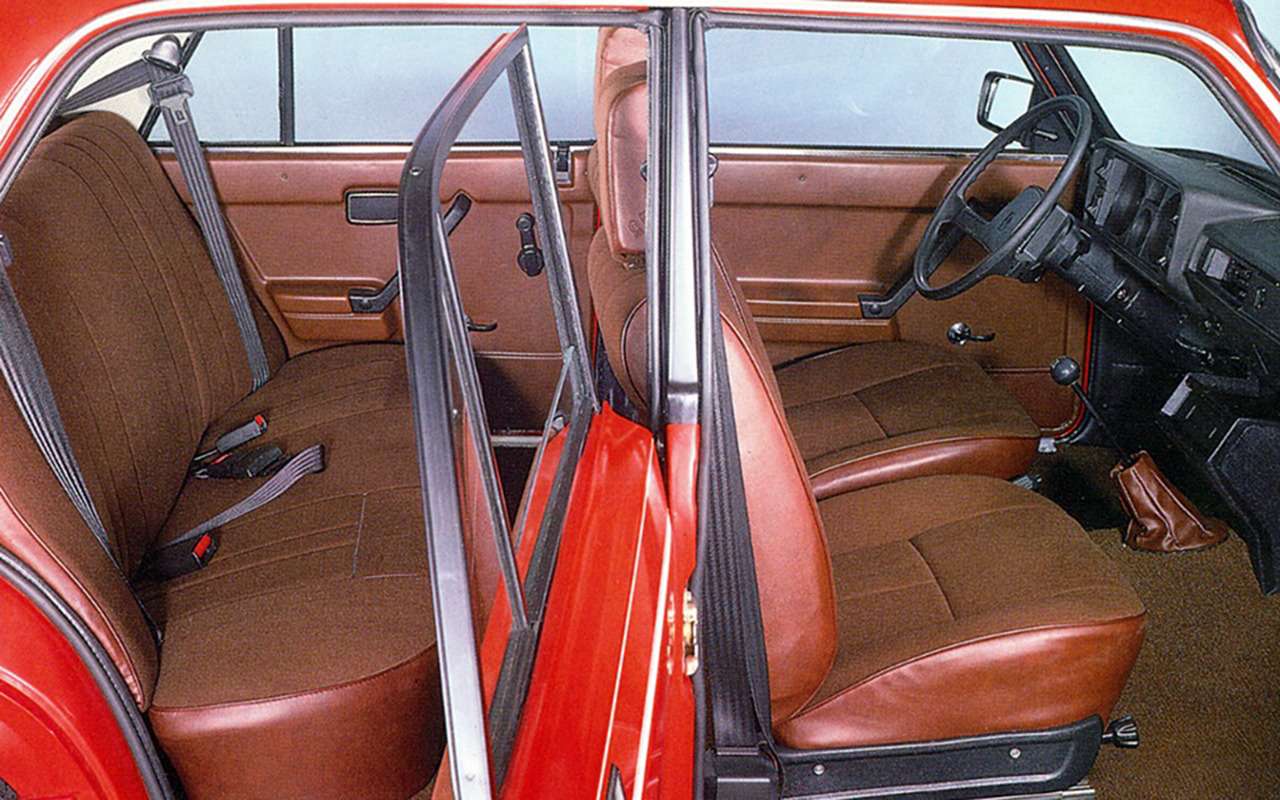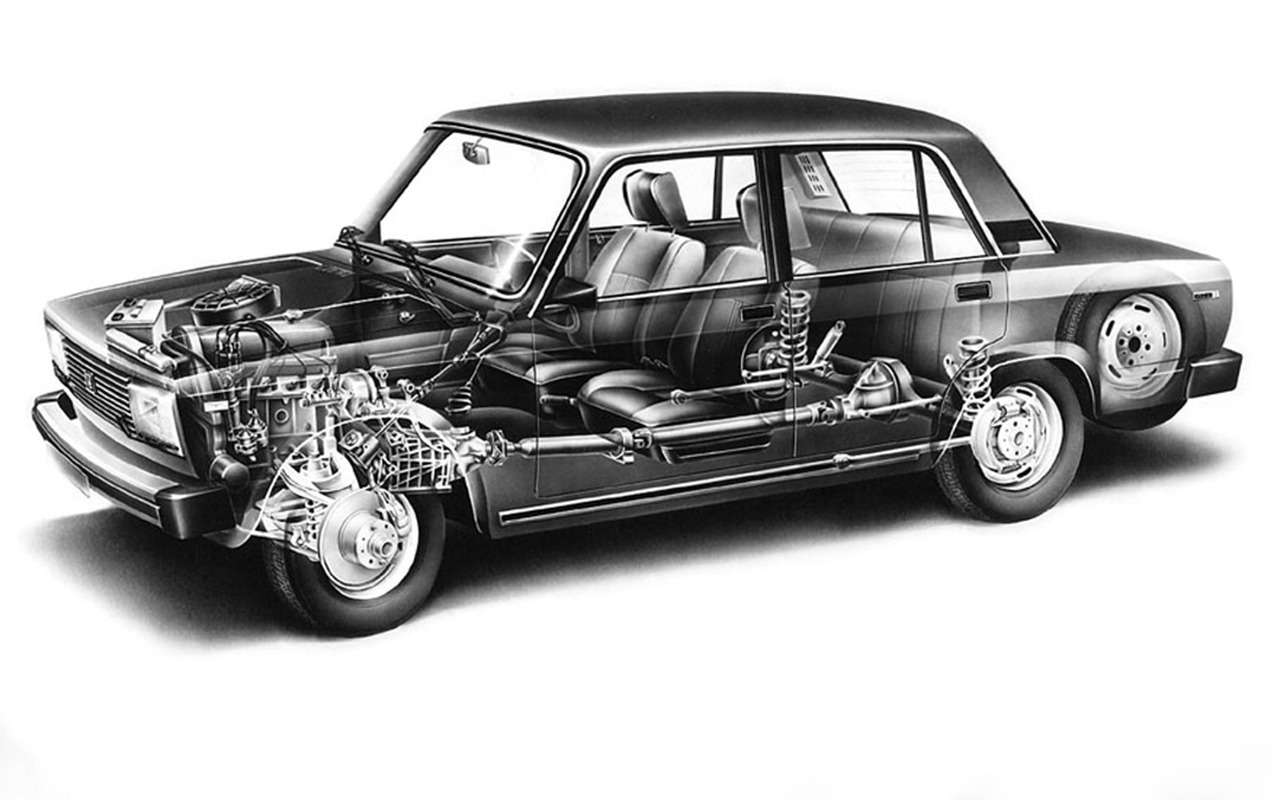with square eyes
According to the chassis, the VAZ-2105 did not differ from the previous Zhiguli.
VAZ-2105 is the first major modernization of the Zhiguli. As prestigious as the “six” was, outwardly it resembled a luxury version of the VAZ-2103. And the VAZ-2105, which debuted in 1980, not only looked fresh – it looked like a foreign car.

The car stood out with a fresh, modern design. New doors and handles, front and rear of the body, massive aluminum bumpers, perfectly combined with the first rectangular headlights of the USSR, combined under one glass with turn signals and with large taillights. By the way, the headlights of the VAZ-2105 at that time were also the most efficient, which was quickly appreciated by buyers who had previously driven other Soviet cars.

In the cabin of the “five” there was a new beautiful instrument panel and a very fashionable steering wheel with a massive center section – more modern than on the previous Zhiguli.

Motorists liked both the molded door panels and the new seats with large (larger than on the Niva and VAZ-2106) headrests. And the “five” is the first Soviet car with front doors without vents and with a mirror, adjustable (manually, of course) from the passenger compartment. Initially, however, mirrors were installed only on the left side.

VAZ-2105 even shook the position of the most prestigious and desirable Zhiguli at that time – VAZ-2106.
Never a FIAT!
Refined motorists saw in the “five” similarities with the FIAT 131 Mirafiori, which debuted in 1974 (modification 131 Supermirafiori has been made since 1978). And it became the first major upgrade of the FIAT 124/125 family – the starting point for our Zhiguli.
In terms of general style, the VAZ-2105 is close to the FIAT 131. But about the same if all the peer models looked similar. Body panels, bumpers, door handles, the interior of the Italian car is different. And the headlights are not aligned with the turn signals. The steering wheel and instrument panel of the VAZ-2105 and FIAT 131 are also different. By the way, for the first time in the Zhiguli in the “five” there were also deflectors for blowing out side windows.
Finally, according to the chassis (platform, as they would say now), the Soviet and Italian cars differed fundamentally. The FIAT 131 has a front suspension of the McPherson type, at the rear – springs and shock absorbers combined into struts. The chassis design of the VAZ-2105 was completely identical to the previous Zhiguli.
In addition, the Italian Twin Cam engine had a double shaft. The “five” also had a new engine, but completely different.
Give a belt

An important difference between the “five” and the previous Zhiguli is the engine with a timing belt (by the way, the first series in the USSR).
A similar design in Tolyatti was tested on experimental engines of the VAZ-E1101 series in the early 1970s. When creating an engine for the VAZ-2105, as uniform as possible with the previous one, the main task was to reduce metal consumption and noise.
The VAZ-2105 engine – the basis for the “five” with a working volume of 1.3 liters (79×66 mm) developed 69 horsepower. at 5600 rpm. The engine caused conflicting, sometimes diametrically opposed, judgments from motorists. He worked very quietly. But the belt was considered unreliable by many. And although the VAZ-2105 engine was “unclogged” (pistons with valves “didn’t come together”), a broken belt on the road is an unpleasant situation. And indeed, in the beginning, not every ride took care of the 60 thousand km before the replacement.
Over time, ordinary 1.2-liter chain engines with a power of 64 horsepower were installed on the “fives”. (VAZ-21051) and 1.5 liter, 77 hp. (VAZ-21053). This version later became the most popular. But many were even happy with a lower-power engine, because the car did not lose its appeal because of this.
In addition to foreign cars

VAZ-2105, under the names Lada Riva and Lada Nova, among others, sold well abroad. And although British witty journalists called Lada a car for dock workers or those who have a portrait of Che Guevara hanging at home, they even paid tribute to the very cheap, but quite harmonious “five”.
It is the harmony of the VAZ-2105 that is “guilty” of the fact that in the West this model was subjected to external tuning to a lesser extent. Usually the case was limited to other rims, black moldings, sometimes a sunroof.
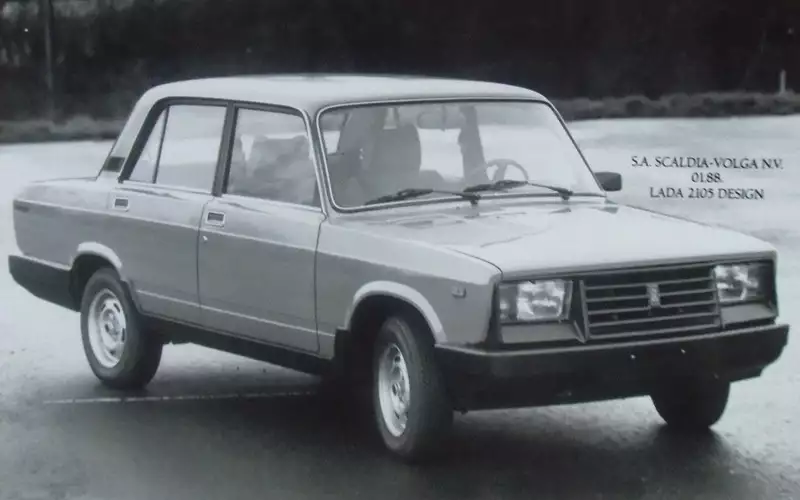
Attempts to do something more serious rarely led to success. For example, in the second half of the 1980s, one of the largest importers of our cars, the Belgian company Scaldia-Volga, tried to embellish the VAZ-2105 with a different radiator grille, massive bumpers and upper sills. It came out like this.

The German version turned out to be more interesting with a custom plastic body kit, solid body colored bumpers and side sills. Later, all this, only more clumsily, appeared with us.
exotic
The VAZ-21055 could become the first serial diesel passenger car in the USSR. The naturally aspirated engine with a working volume of 1.5 liters developed only 53 horsepower. But before the early 1980s, it wasn’t bad.
However, all forces and resources were then devoted to the production of the VAZ-2108. And the “five” with a diesel engine did not go in series. Instead, the “four” appeared – much later and also with adventures.
In 2002, a large VAZ dealer in Moscow, Eleks-Polyus, offered an extended version of the VAZ-2105 and at the same time the VAZ-2104. The cars were meant to work in a taxi, but the carriers showed no interest in them.

Among the sports versions of the “five”, which were made in Lithuania (the famous VAZ-2105 VFTS with a 160 hp engine), Estonia and even in Czechoslovakia (Metalex), the French car stood out. Because she was four-wheel drive!
Poch made an exotic car for the Paris-Dakar rally. At about “five”, French crews took part in the 1983-1987 marathons.
Very few of the “five” in this car are left. The car was built on a spaceframe with lightweight exterior panels. The engine was placed in the base behind the front seats.
The 2.7-litre V6 engine is known as PRV as it was jointly developed and used on their models by Peugeot, Renault and Volvo. On the French Lada, the device developed about 300 hp. A four-wheel drive transmission is made using Niva components and assemblies.
Five to thirty!

In the unofficial rating of long-life Soviet models, the VAZ-2105 takes an honorable fourth place. Cars were made for 30 years – until 2010. In total, more than 2 million “fives” were made. By the way, not only in Tolyatti, but also in Kremenchug, and even in Cairo.
Over time, the shapely door cards disappeared, the steering wheel changed. And on the latest cars they put a dashboard united with the “seven”.
The injection engine with a working volume of 1.5 liters developed 70 horsepower. Of course, the former charm of the “five” is long gone. All that remained was a simple design, studied to the last screw, combined with a low price. The once prestigious Soviet model ended its career as the cheapest on the Russian market.
In the Soviet car hierarchy, this car shook even the most prestigious model of Tolyatti – the VAZ-2106.




